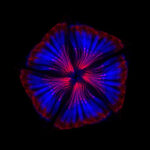The common house fly, often seen as a mere nuisance, is actually a significant carrier of numerous pathogens. Its ability to transmit diseases like dysentery and typhoid fever makes effective fly control crucial, especially in environments where sanitation might be compromised, such as military deployments or disaster-stricken areas. For researchers at the University of Florida (UF), understanding fly behavior is paramount in developing better pest management solutions, leading them to an intriguing discovery about color attraction in flies.
The Surprising Color Preference of Flies: Blue Takes the Lead
Challenging the conventional use of yellow in fly control devices, entomologists at UF’s Institute of Food and Agricultural Sciences (IFAS) made a groundbreaking observation: flies are significantly more attracted to the color blue. In fact, their research demonstrated that flies are three times more drawn to blue than yellow, and surprisingly, yellow even appeared to have a repellent effect. This pivotal finding emerged from a collaboration between UF researchers, including professors Phil Koehler and research scientist Roberto Pereira, and Navy entomology graduates Joseph Diclaro and Jeff Hertz. Their combined efforts, spurred by funding from the Department of Defense’s Deployed War-Fighter Protection program, aimed to enhance protection for military personnel against insect-borne diseases.
To understand this color preference, the team conducted behavioral tests, meticulously observing fly responses to different colors. These experiments revealed a clear inclination towards blue. Further reinforcing this observation, electroretinograms, which measure the electrical activity of the flies’ eyes, confirmed a heightened response to blue light wavelengths. This scientific evidence underscored that the attraction to blue was not accidental but rooted in the flies’ visual perception. The culmination of this research was the development of the Florida Fly-Baiter, a distinctly blue device designed to exploit this very color preference for more effective fly control.
Why Blue? Delving into Fly Vision and Attraction
While the exact mechanisms behind flies’ color vision are complex, this research highlights the importance of visual cues in their behavior. Insects perceive color differently than humans, and for house flies, blue appears to fall within a range of the spectrum that is highly attractive. This could be linked to evolutionary factors, where blue hues might be associated with food sources or suitable breeding environments in their natural habitat. Conversely, the apparent aversion to yellow is less understood but suggests that certain colors might act as deterrents, possibly signaling danger or unsuitable conditions. This nuanced understanding of fly vision opens new avenues for developing targeted and more effective pest control strategies.
Practical Applications of Color Attraction in Fly Control
The implications of this research are far-reaching, extending beyond the innovative Florida Fly-Baiter. This device, now available through pest control distributors, utilizes the principle of color attraction combined with olfactory attractants and a potent insecticide. Unlike traditional fly traps that become ineffective once full, the Fly-Baiter employs a bait-and-kill system, ensuring continuous operation. Its effectiveness was evident in field tests where a single insecticide application eliminated over 40,000 flies.
Moreover, the targeted nature of color-based fly control offers a significant advantage over broad-spectrum methods like aerial pesticide spraying. As Professor Koehler points out, it provides a “much more targeted way to deal with the problem,” minimizing environmental impact and maximizing efficacy. The Florida Fly-Baiter, effective against house flies, phorid flies, and blow flies, represents a significant advancement in pest management, demonstrating how understanding insect behavior, particularly color preference, can lead to innovative and environmentally conscious solutions. The research underscores the potential for further exploration into insect visual ecology to develop even more refined and effective pest control tools in the future.

